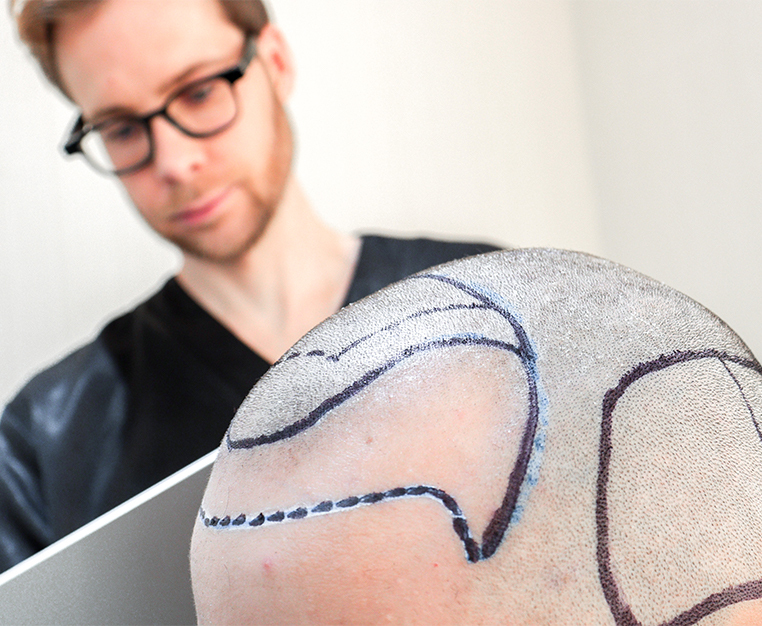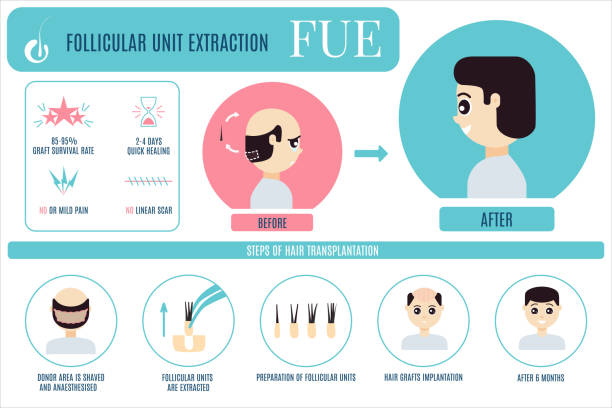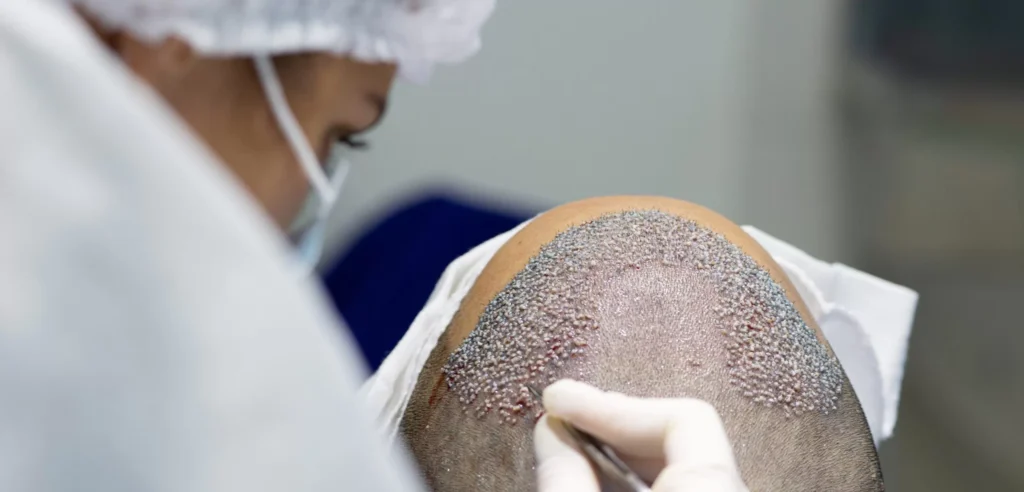Hair Transplants Explained: A Comprehensive Guide to Restoring Your Hair
Hair loss affects millions of people worldwide, often leading to a loss of self-esteem and confidence. Hair transplants offer a permanent and natural-looking solution to this problem, restoring not only your hair but also your confidence. In this guide, we’ll explain everything you need to know about hair transplants, focusing on the popular FUE (Follicular Unit Extraction) technique.
Whether you’re dealing with male pattern baldness, thinning hair, or a receding hairline, understanding the process, the benefits, and what to expect is essential for making an informed decision. This guide will answer all your questions, from how the procedure works to what kind of results you can expect.

What is a Hair Transplant?
A hair transplant is a surgical procedure that moves hair follicles from one part of the body (usually the back or sides of the scalp, known as the donor area) to a balding or thinning area (the recipient area).
There are two main methods of hair transplantation:
- FUT (Follicular Unit Transplantation): A strip of scalp is removed from the donor area, and individual follicles are then transplanted. This method leaves a linear scar.
- FUE (Follicular Unit Extraction): Individual follicles are extracted directly from the donor area using a micro-punch tool and then implanted in the recipient area. FUE leaves minimal scarring and is ideal for those who prefer to keep their hair short.
There are clinics who claim they use different techniques such as DHI or Sapphire Transplant, but these are all variations of FUE or FUT, not a separate technique.

Hair Transplant Variations
FUE is the most popular method, but there are other variations of this technique.
- Direct Hair Implantation (DHI): Similar to FUE but uses a specialized tool for implantation, allowing the surgeon to control the angle, direction, and depth more precisely.
- Robotic Hair Transplants: A robot-assisted method where advanced technology helps extract follicles with high precision. This method is particularly useful for reducing human error and increasing efficiency.
- Sapphire Hair Transplant: This is an FUE performed with a sapphire blade scalpel.
It is important to note that there is limited to no evidence these variations of FUE or FUT provide better results. In most cases, clinics will use these techniques to upsell clients.
Why Choose FUE for Your Hair Transplant?
FUE is by far the most widely used technique which uses a medical punch to extract individual follicles from the donor area. These follicles are then categorised by the number of hairs the contain, typically between 1 and 4 hairs, but can sometimes have up to 6 hairs in a single follicle.
Once the follicles are extracted, incisions are made in the recipient area and the follicles are strategically placed in the incisions.
The reason we take hair from the donor area is because those hairs are genetically resistant to the main cause of hair loss, the hormone DHT.
This also leads to high quality hair in the back and the sides of the head, and unlike body or beard hair, it’s the same as scalp hair, leading to better results, quicker.
FUE offers numerous benefits compared to other methods:
- No Linear Scar: Unlike FUT, FUE doesn’t leave a visible scar, which makes it a better choice for individuals who prefer short hairstyles.
- Faster Healing: Since there are no stitches involved, recovery is quicker, and the discomfort is minimal.
- Precision and Natural Look: Each follicle is implanted following your natural hair growth pattern, leading to results that blend seamlessly with your existing hair.
- Flexible Donor Area: In some cases, FUE can use body hair (from areas like the chest or beard) as donor follicles. However this is not normally recommended in most cases.

Who is a Good Candidate for a Hair Transplant?
A hair transplant might be the right solution for you if:
- You have male or female pattern baldness.
- You have stable hair loss, meaning the rate of hair loss has slowed or plateaued. This is not necessary but leads to better results. If your hair loss is still ongoing or quite rapid, its ideal to address this first with hair loss medication such as minoxidil and finasteride to slow down or completely halt hair loss.
- You are generally healthy with no medical conditions that could complicate the surgery. Typically autoimmune disorders which attack hair follicles or skin conditions that affect the scalp can make you a bad candidate for a hair transplant.
- You have sufficient hair in the donor area to cover the balding area. This is to avoid over harvesting which is when too much is extracted from the donor area causing bald spots or visible scarring.
Consult with a specialist to determine if you are a suitable candidate for FUE or another hair transplant method.
Risks and Considerations of Hair Transplants
As with any surgical procedure, hair transplants come with potential risks, including:
- Infection: Although rare, infections can occur if the scalp is not properly cared for post-surgery.
- Scarring: Even though FUE leaves minimal scars, some patients may still experience slight scarring.
- Shock Loss: In some cases, patients may experience temporary hair loss in the transplanted area, but this is usually followed by regrowth.
It’s important to follow your doctor’s aftercare instructions to minimize these risks.
Results and Recovery Timeline
The recovery timeline for FUE hair transplants typically looks like this:
- First Few Days: You may experience mild swelling, redness, and soreness in the treated area.
- 1 to 3 Weeks: The transplanted hair will start to shed, which is normal and part of the process.
- 3 to 6 Months: New hair growth will begin to emerge.
- 12 to 18 Months: Full results will be visible, with a thicker and fuller head of hair.
It’s important to be patient and follow all post-procedure care guidelines to ensure optimal results. You can find more information on results and recovery here.

How to Avoid a Bad Hair Transplant
Getting a hair transplant is a big decision, and while the results can be life-changing, there are risks if the procedure isn’t performed by a skilled and experienced surgeon. To avoid a bad hair transplant, follow these key tips:
Choose a Reputable Clinic: Research clinics thoroughly before making your choice. Look for reviews, patient testimonials, and before-and-after photos to assess the clinic’s track record.
Verify the Surgeon’s Experience: Ensure the surgeon is board-certified and has significant experience in hair restoration, particularly with the technique you’re considering (FUE, FUT, etc.).
Have Realistic Expectations: Understand what a hair transplant can and cannot achieve. Unrealistic expectations can lead to dissatisfaction, even if the procedure is technically successful.
Post-Op Care: Following post-procedure care instructions is crucial to achieving good results. Neglecting aftercare can jeopardise the outcome, leading to infections or poor growth.
For more detailed information on what can ruin a hair transplant and how to avoid these pitfalls, check out this blog post on factors that can negatively impact your hair transplant.
Taking these precautions will help ensure your hair transplant goes smoothly and delivers the results you’re looking for.
Common Questions Answered
How Long Does the Procedure Take?
A FUE hair transplant can take several hours to complete, depending on the number of follicles being transplanted. The duration varies from patient to patient.
Is the Procedure Painful?
Thanks to local anesthesia, the procedure is generally pain-free. Some discomfort may be experienced post-procedure, but it is typically minimal and manageable with over-the-counter pain relievers.
When Can I Return to Work?
Most patients can return to work within a few days post-procedure, depending on their recovery and the nature of their job. Your doctor will provide personalised advice based on your circumstances.
Are the Results Permanent?
Yes, the results of an FUE hair transplant are permanent. The transplanted hair follicles are resistant to the hormone that causes hair loss, ensuring long-lasting results.
How Much Does It Cost?
The cost varies based on the extent of hair loss and the number of follicles transplanted. Vinci Hair Clinic offers personalised quotes during the initial consultation.
Conclusion
A hair transplant can transform your life, offering a permanent solution to hair loss. Vinci Hair Clinic is a global leader in hair restoration, with extensive experience and a proven track record of success. If you’re considering a hair transplant, don’t wait. Contact Vinci Hair Clinic today to schedule your consultation and take the first step toward regaining your confidence and hair.
With over 100,000 satisfied customers, 20 specialist doctors, and 15+ years of experience, Vinci Hair Clinic is the trusted choice for hair transplants. Visit Vinci Hair Clinic to learn more and book your appointment.


